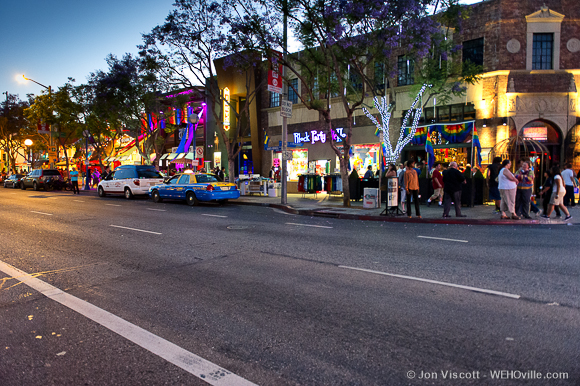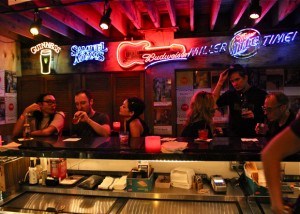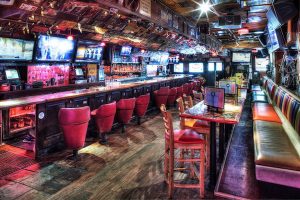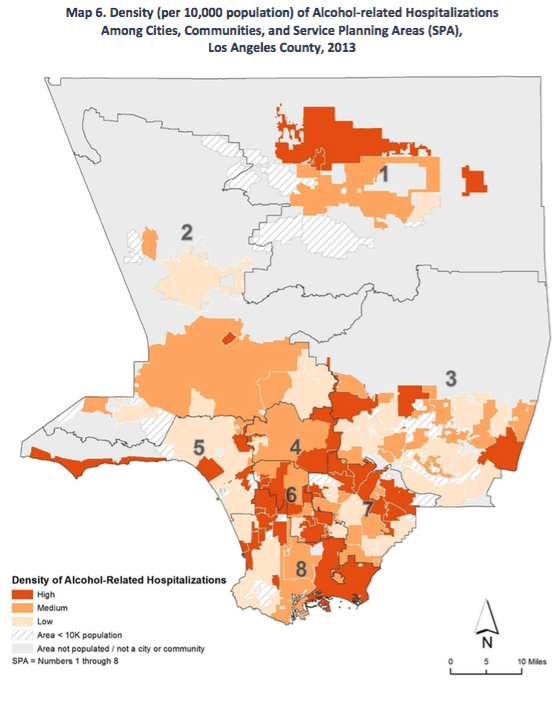
West Hollywood leads every city and community in Los Angeles County in the number of alcohol outlets per 10,000 residents — something several scientific studies have associated with violent crime, car crashes, emergency room visits, hospitalization and death.
A study by the L.A. County Department of Public Health, released Tuesday and based on data from 2013, showed that alcohol was served at 51.1 locations (bars and restaurants) per 10,000 West Hollywood residents. The study found WeHo had 10 off-premises alcohol outlets (liquor stores and grocery stores) per 10,000 residents.
The next closest city was El Segundo, with 39.7 alcohol-serving bars and restaurants per 10,000 residents and 10.7 places that make retail liquor sales. WeHo was far ahead of Beverly Hills, which ranked third in the survey with 38.1 on-premises alcohol outlets per 10,000 residents and 7.5 off-premises liquor vendors. Hermosa Beach had 36 on-premise vendors per 10,000 and 11.7 off-premises vendors, followed by Santa Monica (27.6 on, 7.4 off), Malibu (27.3 on, 11.7 off) and Manhattan Beach (25.3 on, 7.3 on). The study found that that there is an average of 8.9 on-premises outlets and 6.2 off-premise outlets per 10,000 people countywide.

The study, which covered 86 cities and 33 unincorporated areas with populations of 10,000 or more people, found a correlation between the density of alcohol retailers and violent crimes in an area. Those with a high density were 3.7 times more likely to experience violent crimes than those with a low density, even after taking into account the income level of a community (typically poorer communities experience more crime). However there was no statistically significant relationship between incidents of violent crime and the density of on-premises alcohol establishments, which suggests that the number of alcohol-serving bars and restaurants in West Hollywood doesn’t contribute to violent crime in the city.
The study also didn’t find any correlation between the density of alcohol establishments and alcohol-related deaths or alcohol-related traffic accidents. Given the small size of West Hollywood — 1.89 square miles — it is possible that those driving under the influence of alcohol consumed in West Hollywood may get into accidents outside the city limits.
One major impact of having lots of alcohol-serving establishments is alcohol-related illness. The study found that cities and communities with a high density of on-premises alcohol outlets were 2.1 times more likely to have high alcohol-related hospitalization rates than cities and communities with a low density of on- premises outlets. Those with a high density of off-premises alcohol vendors were twice as likely to have high alcohol-related hospitalization rates than cities and communities with a low density.

West Hollywood ranked 25th in alcohol-related hospitalizations among the 119 cities and areas studied, with 45.9 incidents per 10,000 residents. The worst was Willowbrook, with 115.6 incidents. The Los Angeles County average was 45.1 hospitalizations per 10,000 residents.
West Hollywood ranked fifth in visits to emergency rooms or emergency care facilities because of drinking. The study found 80.7 visits per 10,000 WeHo residents compared with a countywide average of 58.1 emergency room visits per 10,000 residents.
“Excessive alcohol consumption continues to be a serious public health concern with substantial implications for disease, violent crimes, traffic collisions, work loss, and social relationships,” the study says. “During 2013 in Los Angeles County, alcohol was involved in an estimated 4,420 motor vehicle crashes, 6,338 motor vehicle injuries, 246 motor vehicle fatalities, 63,424 ED (emergency room) visits, 56,191 hospitalizations, and more than 2,800 alcohol-attributable deaths.
“Drinking among youth and adults is strongly influenced by environmental or structural factors, such as alcohol control policies, retailer marketing strategies, as well as alcohol access and availability.
According to the study, reducing the density of bars and alcohol-serving restaurants is one way to reduce alcohol-related crimes and injuries or illness. “For example, eliminating one bar per zip code was estimated to lead to 290 fewer serious assaults per year in California,” the study says.
It notes that while the state Alcoholic Beverage Control (ABC) agency determines who can sell alcohol, local authorities and community members can get involved by objecting to issuing new licenses or pressing for the revocation of liquor licenses granted to businesses that violate the law. Cities also can require establishments selling alcoholic beverages to obtain conditional use permits that restrict the hours of sale and impose other requirements. The City of West Hollywood has such requirements in place.
West Hollywood also has been working with local liquor vendors and bar and restaurant owners through the Safe WeHo Leadership Council to encourage them to train bartenders not to serve those who are obviously intoxicated, not to over-pour drinks and to be vigilant in ensuring they don’t serve to minors. The council, which was formed earlier this year, includes city staffers, bar owners, representatives of law enforcement and public health advocates. Its goal is to develop actions to reduce alcohol-related problems that are relevant to the WeHo community. Among the strategies under consideration are adding a dedicated alcohol enforcement officer to the entertainment policing team, whose focus is the city’s bars and nightclubs, and having undercover officers check bars to see that they are complying with the law.
EDITOR’S NOTE: An earlier version of this story reported that the Safe WeHo Leadership Council had suggested adding a dedicated alcohol enforcement officer and undercover officers to check bars to the Sheriff’s station’s entertainment policing team. In fact, those ideas are under consideration but have not been proposed or recommended by the council. The story has been corrected to reflect that.


DUH! And yet nothing about the harm and danger (in all ways) to the 35,000 residents squeezed in tiny weho, the alcohol (and tax revenue passing into the city, but no knowledge where that tax revenue is spent) capitol.
And soon to be LA County’s place to go for meth products? In the race to be number one.
Is this really that big of a reveal? We are also one of the most population-dense cities west of the Mississippi, and are a destination for our nightlife.
Duh! Draining this swamp will be tantamount to holding back a tsunami. The city coffers benefit even though the citizens and visitors are ground up in the gears. Its the price of business they would claim.
so sad, but not a surprise.